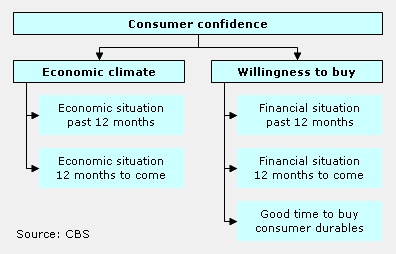consumer spending marginally up, consumer confidence hardly changes

According to figures released by Statistics Netherlands today, household spending on goods and services was 0.5 percent up in December 2014 from December 2013. For the third month in a row, consumption increased marginally. Consumption growth was affected by a slump in car sales. Consumer confidence remained fairly stable in February relative to January.
Consumption figures have been adjusted for price changes and differences in the shopping-day pattern.
Household spending on cars down, more spent on natural gas and services
Household spending on durable goods was 1.8 percent lower in December. In October and November spending on durable goods had been higher than one year previously. In December 2014, consumer spending on cars slumped relative to December 2013, when car sales peaked due to the fact that a favourable tax law expired on January 2014.
Consumers bought more bicycles in December 2014 compared to December 2013 because an arrangement to the effect that employers make a financial contribution, if employees purchase a bicycle to travel between home and work, was abolished.
Dutch consumers spent 0.6 percent more on food, drinks and tobacco products than last year. Spending on other goods was up by 1.5 percent. Consumers spent more on natural gas. Household spending on services - accounting for more than half of domestic consumer spending - grew by 0.9 percent. Services include rent, public transport, restaurants, hairdressers, telephone services and insurance premiums.
Circumstances for consumption improved in February
According to the Statistics Netherlands Household Consumption Radar circumstances for Dutch household consumption improved in February relative to January. Manufacturers were less negative about future employment in their sector. The rise in Dutch share prices compared to one year previously was more substantial than in the preceding year. On the other hand, Dutch consumers were more pessimistic about future unemployment. By means of six indicators, the Household Consumption Radar shows whether circumstances for Dutch household consumption have become more or less favourable.
Consumer confidence hardly changes
The mood among consumers has hardly changed in February compared to January. Consumer confidence was - 7 in February, versus - 6 in January. Consumers’ opinions about the economic climate were more negative; their willingness-to-buy remained unchanged.
With - 7, consumer confidence in January was above its long-term average over the past two decades (- 8). Consumer confidence reached its highest level ever in April 2000 (27) and its lowest level in February 2013 (- 44).
Opinion about economic climate deteriorates, willingness-to-buy unchanged
The component indicator Economic climate was - 5, versus - 2 in January, because consumers were less positive about the future economic situation. The component indicator willingness-to-buy did not change from January to February (- 9).
Consumer confidence

Source, StatLine:
For more information on economic indicators, see the Economic Monitor.